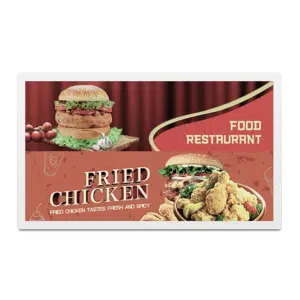The Environmental Benefits of Using Electronic Paper Displays
The Environmental Benefits of Using Electronic Paper Displays
Blog Article
Display technology is becoming an integrated part of our everyday lives, appearing in everything from smartphones and e-readers to large-scale marketing panels. One of the varied array of custom E ink display, OLED (Organic Light-Emitting Diodes), and LED (Light-Emitting Diodes) have surfaced as some of the very most generally discussed options. While each type provides its own distinctive function, their variations in characteristics, efficiency, and use cases make sure they are suited to particular applications. Let's take a deeper consider the key characteristics of those display technologies.
Electronic Paper displays (ePaper)
Electronic Paper displays, also referred to as ePaper or Electronic Ink displays, are designed to imitate the look and readability of traditional Ink on paper. That technology employs little microcapsules containing priced dark and bright contaminants halted in a definite fluid. When an electrical field is applied, the contaminants move to either side of the capsule, making a visible image. The picture stays fixed until still another electric area is used, rendering it well suited for displaying text-based content such as books, newspapers, and e-readers.

Among the principal features of ePaper displays is their minimal energy consumption. Unlike traditional LCD
Understanding Electronic Paper displays
An electronic Paper display (ePaper) mimics the look of Ink on paper. Unlike traditional displays, ePaper relies on their power to reflect normal light as opposed to emitting their own. This technology not only diminishes attention strain but also offers unmatched readability in sunshine, rendering it suitable for e-readers and digital signage solutions.
One standout function of ePaper displays is their amazingly reduced energy consumption. Since they simply use energy when adjusting content, ePaper screens are very effective and suitable for battery-powered devices. However, their renew costs are slower in comparison to OLED and LED displays, restraining their applicability to fixed or minimally dynamic content.
OLED displays
OLED displays are known for their gorgeous visible quality, giving lively shades, heavy greens, and exemplary contrast. Each pixel within an OLED display emits a unique light, reducing the requirement for a backlight. That not only allows for thinner, more light types but additionally results in better energy effectiveness compared to LED using scenarios.
One key advantage of OLED displays is their flexibility. They could be produced in bent or flip-up models, creating them popular in cutting-edge smartphones and wearable devices. Nevertheless, OLED monitors include problems, such as for instance susceptibility to burn-in and shorter lifespans in comparison to different technologies.
LED displays
LED displays, the most frequent of the three, count on a backlit process to mild their pixels. While not as successfully striking as OLED 13.3" epaper display, LEDs are very tough, long-lasting, and cost-effective. These characteristics make them suited to a larger array of applications, including TVs, pc screens, and outdoor advertising.
LED displays an average of perform well with regards to perfection, making them a good choice for surroundings with high surrounding light. But, they are unsuccessful in reaching the exact same deep distinction and color reliability as OLED technology.

Ultimate Comparison
When choosing between ePaper, OLED, and LED displays, the decision depends mainly on the supposed purpose. For fixed content like studying or signage, ePaper excels with its low power utilization and large exposure in natural light. OLED shines in programs wherever vibrant colors and freedom are paramount. Meanwhile, LED stays a trusted and cost-efficient solution for a variety of general-purpose needs.
Each display engineering brings anything unique to the dining table, ensuring that there is a great selection for every situation. Understanding these variations will help users and companies produce informed conclusions that match their certain display requirements. Report this page